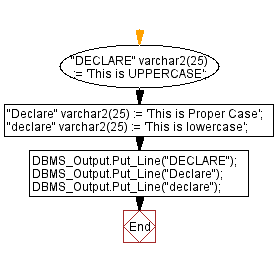PL/SQL Fundamentals Exercises: PL/SQL block to show Reserved Word as User-Define Identifier
PL/SQL Fundamentals: Exercise-3 with Solution
Write a PL/SQL block to show a reserved word can be used as a user-define identifier.
In the example below quoted user-defined identifiers "DECLARE", "Declare", and "declare" have been declared. The word DECLARE, Declare and declare represent the same reserved word, "DECLARE", "Declare", and "declare" represent different identifiers.
PL/SQL Code:
DECLARE
"DECLARE" varchar2(25) := 'This is UPPERCASE';
"Declare" varchar2(25) := 'This is Proper Case';
"declare" varchar2(25) := 'This is lowercase';
BEGIN
DBMS_Output.Put_Line("DECLARE");
DBMS_Output.Put_Line("Declare");
DBMS_Output.Put_Line("declare");
END;
/
Sample Output:
This is UPPERCASE This is Proper Case This is lowercase Statement processed. 0.16 seconds
Flowchart:

Go to:
PREV : Write a PL/SQL block to show an invalid case-insensitive reference to a quoted and without quoted user-defined identifier.
NEXT : Write a PL/SQL block to show the result to neglect double quotation marks in reserved word identifier.
Improve this sample solution and post your code through Disqus
What is the difficulty level of this exercise?
